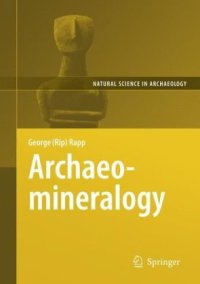
Ebook: Archaeomineralogy
Author: George Rapp (auth.)
- Genre: Biology // Ecology
- Tags: Geology, Mineralogy, Archaeology, Anthropology
- Series: Natural science in archaeology
- Year: 2009
- Publisher: Springer-Verlag Berlin Heidelberg
- City: Berlin; London
- Edition: 2
- Language: English
- pdf
Archaeomineralogy provides a wealth of information for mineralogists, geologists and archaeologists involved in archaeometric stuides of our past. The first edition was very well recieved and praised for its systematic description of the rocks and minerals used througout the world by our ancestors and for its excellent list of over 500 references, providing easy access to the fields of archaeomineralogy and geoacrchaeology.
This second edition of Archaeomineralogy takes an updated and expanded look at the human use of rocks and minerals from the Paleolithic through to the 18th century ACE. It retains the structure and main themes of the original edition but has been revised and expanded with more than 200 new references in the text, a bibliography of useful references not included in the text, a dozen new figures (drawings and photos), coverage of many additional important mineral, rock, and gem materials, increased geographic scope, particularly but not limited to Eastern Europe, and a more thorough review of early contributions to archaeomineralogy especially those of Agricola.
What is archaeomineralogy? The term has been used at least once before (Mitchell 1985), but this volume, now in an updated and expanded Second Edition, is the first modern publication to lay down a scholarly basis and the systematics for this subdiscipline. Students sometimes call an introductory archaeology course “stones and bones”. Archaeomineralogy covers the stones component of this phrase. Of course, archaeology consists of a great deal more than just stones and bones. Contemporary archaeology is based on stratigraphy, geomorphology, chronometry, anthropology, and a host of other disciplines in addition to those devoted to stones and bones (Rapp and Hill 2006).